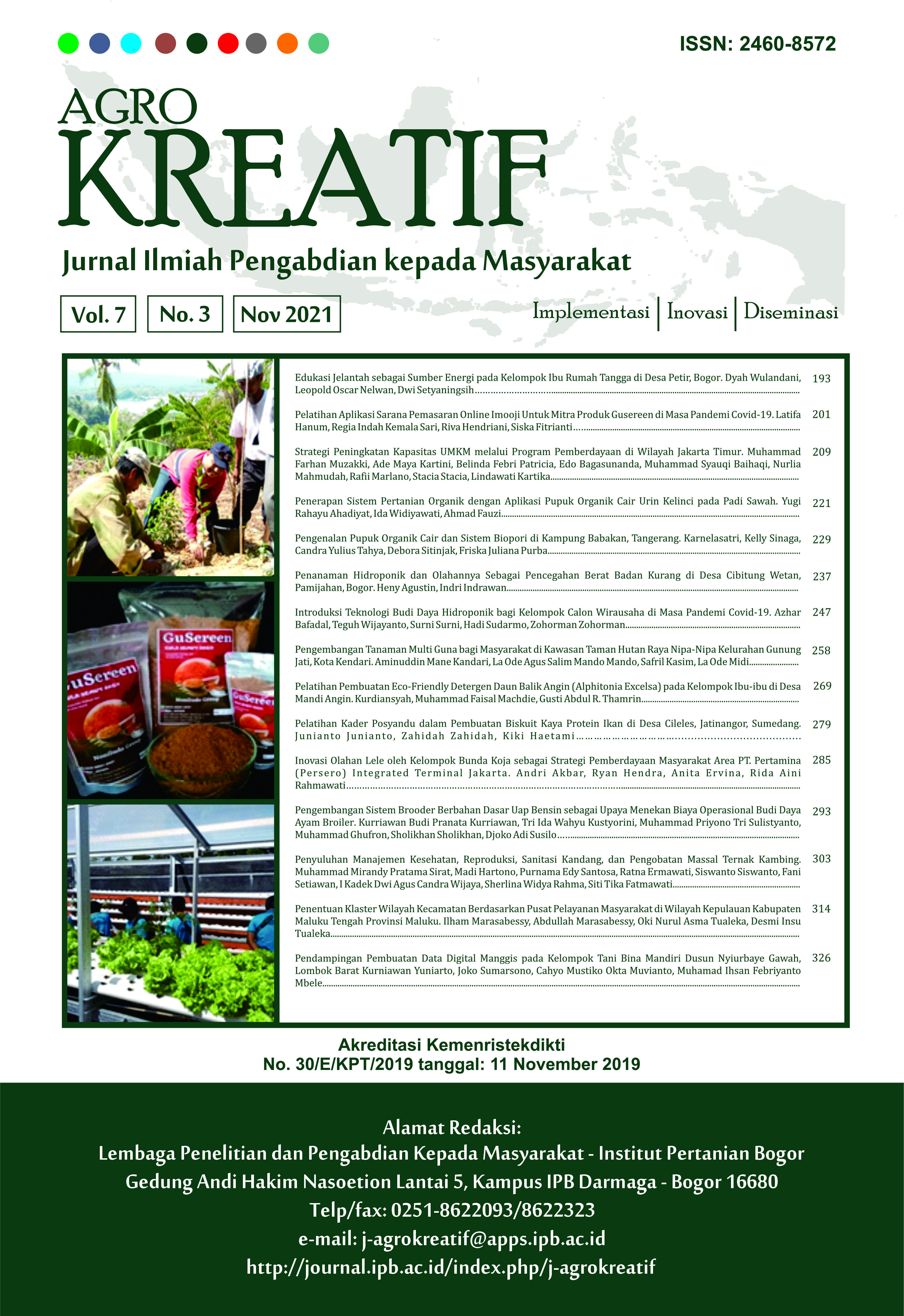Edukasi Jelantah sebagai Sumber Energi pada Kelompok Ibu Rumah Tangga di Desa Petir, Bogor
Abstract
Jelantah is the used cooking oil. After being used more than three times for frying, the oil will be oxidized by ambient air, and dangerous free radical compounds are formed. Consuming of jelantah in certain amounts, can trigger diseases such as blockage of blood vessels, cancer and nervous disorders. In addition, jelantah discharged into the drains will cause blockage of drains and kill water ecosystems. However, jelantah can be used as an energy source and other products that have economic value. The purpose of this activity is to provide education for groups of housewives in Babakan Gang Salak, Petir Village, Bogor Regency regarding the dangers and benefits of jelantah, introducing simple technology of biodiesel production. The methods used include questionnaires, training and monitoring. The 1st, 2nd and 3rd trainings were held with different participants in the same location. The the participants’ enthusiasm and local site leaders was very high and they wished training for a wider range of participants. The training has been conducted successfully, which was showed that most of the participants could increase their skills and knowledge about the dangers and benefits of jelantah is biodiesel production. This knowledge is supposed to be applied in everyday life by not consuming jelantah for frying food, but it is used as a raw material for biodiesel production.
Downloads
References
Allice SCV, Rayana LG, Maria EAT,Inês CG, Ana PMMC, Beatriz da CAA, Sabrina AL, Luiz CMV, Giovana RT. 2021. Supplementation of polyunsaturated fatty acids (PUFAs) and aerobic exercise improve functioning, morphology, and redox balance in prostate obese rats. Nature Portofolio/Scientific Reports. 11: 62–82. https://doi.org/10.1038/s41598-021-85337-9
Fatimura M, Daryanti, Santi. 2016. Pembuatan biodiesel dari minyak jelantah bekas rumah makan dengan variasi penambahan katalis KOH pada proses transesterifikasi. Jurnal Redoks. 1(2): 35–43. https://doi.org/10.31851/redoks.v1i2.2027
Ibrahim AZ. 2017. Rancang bangun reaktor dengan menggunakan helical screw agitator dan baffle untuk produksi biodiesel secara batch. [Skripsi]. Bogor (ID): Institut Pertanian Bogor.
Ketaren S. 1986. Pengantar Teknologi minyak dan lemak pangan. Jakarta (ID): UI Press.
Leung DYC, Wu X, Leung MKH. 2010. A review on biodiesel production using catalyzed transesterification. Applied Energi. 87(4): 1083–1095. https://doi.org/10.1016/j.apenergy.2009.10.006
Meila M, Muhartono. 2019. Konsumsi minyak jelantah dan pengaruhnya terhadap kesehatan. Majority (Medical Journal of Lampung Univerity). 8(2): 259–264.
Minihane AM, Lovegrove JA. 2006. Health benefits of polyunsaturated fatty acids (PUFAs). In: Improving the Fat Content of Foods. Woodhead Publishing Series in Food Science, Technology and Nutrition. https://doi.org/10.1533/9781845691073.1.107
Natalia ES, Wasi SWP. 2017. Pengolahan minyak goreng bekas (jelantah) sebagai pengganti bahan bakar minyak tanah (biofuel) bagi pedagang gorengan di sekitar FMIPA UNNES. Rekayasa-Jurnal Penerapan Teknologi dan Pembelajaran. 15(2): 89–95.
Rosye HRT, Baigo H, Alianto. 2019. Konsentrasi surfaktan dan minyak di Perairan Depapre, Kabupaten Jayapura, Popinsi Papua. Buletin Oseanografi Marina. 8(1): 49–54. https://doi.org/10.14710/buloma.v8i1.22264
Sottero B, Leonarduzzi G, Testa G, Gargiulo S, Poli G, Biasi F. 2019. Lipid Oxidation Derived Aldehydes and Oxysterols Between Health and Disease. European Journal of Lipid Science and Technology. 121(1): 1–16. https://doi.org/10.1002/ejlt.201700047
Suroso AS. 2013. Kualitas minyak goreng habis pakai ditinjau dari bilangan peroksida, bilangan asam, dan kadar air. Jurnal Kefarmasian Indonesia. 3(2): 77–88.
Taufik M, Seftiono H. 2018. Karakterisitik fisik dan kimia minyak goreng sawit hasil proses penggorengan dengan metode deep-fat frying. Jurnal Teknologi. 10(2): 123–129.
Vivi T. 2006. Macam-macam vitamin dalam tubuh manusia dan fungsinya. Jurnal Kesehatan Masyarakat. I(1): 40–47.
[WHO] World Health Organization. 2006. WHO guidelines on hand hygiene in health care (advanced draft)- World alliance for patient safety-Global patient safety challenge (2005–2006)- clean care is safer care.
Zahra SL, Dwiloka B, Mulyani S. 2013. Pengaruh penggunaan minyak goreng berulang terhadap perubahan nilai gizi dan mutu hedonik pada ayam goreng. Animal Agriculture Journal. 2(1): 253–260
This work is licensed under a Creative Commons Attribution-NonCommercial 4.0 International License.



















